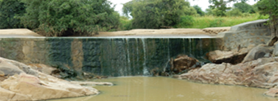Sand Dam Sudan

Most of the world copes with increasing water scarcity during the period of low rainfall and drought further augment by the impact of the climate change on temporal rainfall patterns. Decentralized storage of water is an important strategy in arid and semi arid regions out side the reach of perennial, spring, deep ground water, or other water sources.
The quantity of the water is protected against evaporation and contamination, water quality is even improved through the natural filtration the soil. The technology of the sand storage dams is not new: storage of the rainfall and runoff, including sub-surface storage, for beneficial use has been applied since 9.000 BC.
For first time there is question: what sand dam is?
Sand dam is type of sub-surface dam built across seasonal rivers. It provides a mean of increasing water storage capacity by accumulating sand and gravel upstream of the dam, which is raised progressively after each rainy season until it reach appropriate height .
This incremental raising should be to such an extent that it allows finer materials such as silt to be washed out of the deposited sand and gravel by turbulence created at time of overflow. The coarser sand and gravel collected by the dam, the greater size of voids and there for, potential storage capacity. Gravel and coarser sand can store up to 35% of their total volume as water.
The final height of the dam is governed by the bank height at its extremities and in any case, should not be greater than about five meter. It should be constructed preferably in concrete or masonry, because it’s upper surface acts and over flow weir and has to resist the erosive action of water which is laden with silt and suspension.
That abbreviated definition is creating directly a question about the function of the sand dam or (SSD) (Sand storage dam), so we can say the primary function of sand dam is increasing the water availability by storing water in the sandy bed of the rivers and banks in the voids in sand .sand dam can obstruct ground water flow through the river bed resulting in (continuous, replenished, enlarged ground water reservoir upstream the dam.
By no means there are great advantages at the use of sand dam for water harvesting programs compared to to surface dam, and these include:
- Protection against evaporation, Losses from evaporation are very much lower than those from an exposed surface in dry and tropical areas.
- The breed of insects and parasites such as mosquito and bilharzias parasites is prevented.
- Contamination of stored water by people and animals is greatly reduced particularly as well and hand pump can be provided to abstract water in hygiene and controlled manner.
- The natural filtration of water flowing throw the river bed sand disinfection.
- Inexpensive structure high level of community involvement.
Beside all that sand dams can have other functions and positive side effects, as:
- Regional ground water recharge.
A cascade of sand dams in a will cause general rise in ground water levels in a larger area .this improve the environment in the surrounding area of the dam, due to the more water availability for people and animals.
- Sand harvesting and rehabilitating the gullies.
Sand dam can rehabilitate erosion gullies, while the sand sediments behind the dam can harvest surface water because the sand storage dam is built for this purpose so the dam does not have to be impermeable.
Sand dam as new idea in Sudan
There is previous experience in Sudan before in construction of dam at the permanent and seasonal rivers as the river Nile. But the different of this, why we construct the dam? In Sudan all the dams are built to harvest exactly the surface water or to raise the ground water table. Also we can find (by accident) some designs semi to sand dam. So easily we can say without hypocrisy, SOS SAHEL is the pioneer in transferring this technology to Sudan as anew initiative .SOS SAHEL did exchange visit to Kenya and see directly the impacts of sand dam in different districts like kitwi which is famous instance for sand dam. They began constructing sand dam since 1995, since this period, over 500 sand storage dams had been constructed with vary in size according to the valley dimensions and peak flow. On the average, kitwi dams are between 2 m – 4m height and around 20 meter in length.
The main advantage of the kitwi dams that they use a simple expensive technology and can be constructed by the local community mainly with available local material, and that which SOS SAHEL is seeking for that to separate this technology among communities in south kordofan. The cost average sand dam with minimum life span of 50 years and storage at least 2.000 m³ is about 7500$ and some of 40% – 20 % is provided by the community. They are involved in the construction of sand dam by provision labor and raw materials throw sand dam management group. After construction, these groups ensure maintenance of dams and protection of water quality as well as promotion of ownership and thus sustainability.
Sand dams always built in sequence because the ecological damage resulting from having point water source is avoided, also the water table rises higher and over large area compared to individual unites this will result in ecological regeneration. Apart of drinking water security, sand dam also provide water for development of rulur commercial activities such as:
- Small scale irrigation cash crops and tree necessaries.
- Piped water supply to nearby villages and industrial activities (brick making).
- Since less time is needed to fetch water.
School attendance is increasing significantly more time can be spent on other income generation.
So (As SOS SAHEL) we are very interested to start this project in Sudan within program of three years and start training program in sand dam construction to separate this technology among our communities.
A sand storage dam (or sand dam) is a small dam build on and into the riverbed of a seasonal sand river1. The functioning of a sand dam is based on sedimentation of coarse sand upstream of the structure, by which the natural storage capacity of the riverbed aquifer is enlarged. The aquifer fills with water during the wet season, resulting from surface runoff and groundwater recharge within the catchments. When the riverbed aquifer is full, usually within one or two large rainfall events, the river starts to flow as it does in the absence of the dam. However, the groundwater flow through the riverbed is now obstructed by the sand storage dam, creating additional groundwater storage for the community.
Principal of sand dam is?
During the dry season, water levels will drop due to abstraction of water, minor evaporation and possibly by leakage through the dam or vertical leakage into the bedrock. Meanwhile, subsurface flow (base flow) from the riverbanks towards the riverbed and through the riverbed itself will slowly and partly refill the riverbed aquifer. Because of the larger storage volume and he slower depletion, the river provides water throughout the dry season (when built under appropriate conditions), whereas otherwise the riverbed would have dried up long before the beginning.
The volume of water available for abstraction is considerably larger than just the volume present in the riverbed sands. This is because a large quantity of the water is additionally stored in the new rains.
Riverbanks, recharging the sand dam reservoir in the dry season
Sand dams effectively increase the volume of groundwater available for abstraction as well as Prolonging the period in which groundwater is available.







